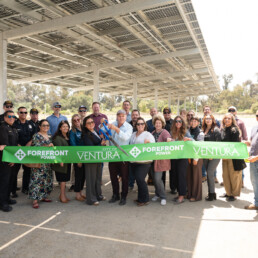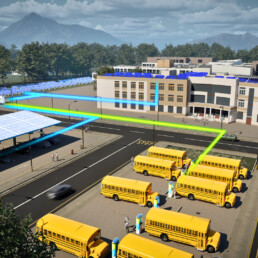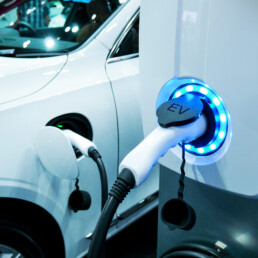Following the completion of our solar project for LaGuardia Airport, we spoke to the Sustainability Director at the Port Authority of New York and New Jersey Christine Weydig to learn her takeaways from the solar procurement process and hear advice she has for other airports and public agencies seeking to make their infrastructure more sustainable.
Why did the Port Authority of New York and New Jersey pursue a renewable energy project?
CW: The Port Authority has been looking at opportunities to do renewables across our facilities, and in a lot of cases, we’re constrained by major redevelopment programs. If you think about a solar installation of this kind, it really needs to stay in place for usually about 20 years, (sometimes even longer), to really get the full benefit of the project. Knowing that many of our facilities are slated for redevelopment, it really narrows some of the opportunities that we have to develop on-site solar. But we do, on a continuous basis, look across our portfolio to see if we have roofs that are viable candidates for solar. That really depends on the condition of the roofs and potential shading by other large buildings or structures.
At airports, specifically, it’s even more nuanced because you need to do a glare analysis to make sure you’re not interfering with any aeronautical operations. If you think about incoming aircraft, you really don’t want to produce glare that could interfere with the maneuvering of aircraft.
LaGuardia is a brand new, beautiful airport we’ve been in the midst of redeveloping the airport for a number of years. The Terminal B Garage had a brand new roof, so we knew it was, structurally, a really great candidate, and it had the scale that we needed. There wasn’t a lot of equipment on the roof that we needed to work around. We really did zero in on this as one of our prime opportunities for on-site renewables at the new LaGuardia Airport.
We’re looking at other opportunities as we speak to expand renewables at LaGuardia. But it really was a combination of opportunity, structural integrity, and building loads. Making sure that we weren’t out in the hinterland of the airport where you could produce power, but then needing it to go a great distance to where the power would be needed. It really hit that sweet spot.
Why is LaGuardia’s Terminal B Parking Garage a key facet of the airport’s overall sustainability efforts?
CW: For all of our new construction projects, we have these ambitious, sustainable design requirements. Terminal B, for example, is the first LEED gold-certified air terminal. It really made sense as part of the package to include solar on the roof of the garage. The roof of this terminal itself wasn’t the best candidate because of certain architectural features. We looked at what proximate structures could host the solar system, and the garage was one that really made the most sense.
What was ForeFront’s role in the project?
CW: We couldn’t have done the project without ForeFront Power. We didn’t have our own capital to invest in this type of solar system. We’re also a public entity, so we don’t pay taxes. There are other payments in lieu of taxes that we provide to our local municipalities. But because of the way some solar incentives are structured, it really requires a partner that has a tax appetite.
Bringing in a private partner that not only has the capital, but has the expertise, and knows how to construct, operate, and maintain these systems is really important to the success of a project. It also makes the project much more financially viable because you can monetize some of these tax incentives when you bring in a private partner.
We ran a competitive process to identify a developer for the project, and ForeFront was the most competitive among those. It’s really been a great partnership. As with many construction projects in the early days, there were certain challenges that we faced related to constructability, but ForeFront was really a great partner in navigating those and finding a way forward for the project.
What are some of the Port Authority’s learnings from installing solar energy?
CW: On the design side, we are our own building department. We actually review and approve the designs for any construction project, including a solar project. We are still in the early days of our engineering group understanding how these projects work. I think that’s why collaboration with a private partner like ForeFront is really important, even in terms of educating our own staff on what to expect when they review drawings for a solar project or interconnection requirements.
When we look at contracts, for example, our legal team is familiar with leases or construction contracts, but not necessarily a power purchase agreement embedded within those construction requirements, and roles and responsibilities in terms of maintenance. Those are all things that are still relatively new to the agency. I feel like we’re definitely further up the learning curve, but it really does take that close collaboration to get us where we need to be to really accelerate.
Do you have advice for other airports, public agencies, and large organizations considering solar energy?
CW: For any new construction, try to bake it into the design at the outset. Even if it isn’t installing the solar panels as part of the construction project, it’s about making sure that you’re keeping solar in mind as you construct a structure, so it’s solar-ready. The roof has the load-bearing capacity that could support a solar system and the orientation of any equipment that’s on a rooftop allows for potential future development of solar.
Getting familiar with the FAA’s requirements as it relates to glare analysis is also important. Even looking at what the opportunity is for existing buildings or other parts of the airport. We’re pursuing solar carports at a number of our parking lots. That is a really good opportunity for an airport because it’s property that is likely to be openly available and not shaded for the amount of time required to realize the full benefits of a solar system.
Especially now, it can also be coupled with electric vehicle charging infrastructure. Having the complement of renewable energy and EV charging really gives you that true zero emissions vehicle that you want instead of zero tailpipe. There really are a lot of unique opportunities that are available to airports today. To the extent that these airports often are operated by public entities, it really is about bringing that private partner in that can help monetize some of the tax incentives and make the project pencil. That’s something that I think our learnings can be really beneficial toward as we work with our partners at other airports.
Interested in learning more?
We would love to discuss how our solutions might be a fit for your organization. Contact one of our solar, storage, or e-mobility experts today:







